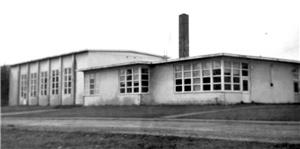On October 30, 1943, the Sinclair Park Community Center in Bremerton (Kitsap County) hosts its first Halloween party. The community center is part of Sinclair Park, a housing development located just west of Bremerton that has recently opened for Blacks and their families who are moving to the city for work during World War II. The development's name comes from nearby Sinclair Inlet, but because of its lofty locale atop a hill, it will commonly be called Sinclair Heights. For the next several years the community center will be the nexus for business, entertainment, and socialization for many of Sinclair Height's residents and other local Blacks. As an 11-year-old child, future musician Quincy Jones (1933-2024) will teach himself to play the piano in the community center's recreation room.
Sinclair Park
The Sinclair Park housing development was built in 1942 and 1943 to meet the needs of Bremerton's surging Black population, who came to the city by the thousands to work at the Navy Yard Puget Sound (now the Puget Sound Naval Shipyard) during World War II. Of nine housing developments built in or near the city to house workers during the war, Sinclair Park was among the last completed. Official government policy did not call for the developments to be segregated, but as they opened in Bremerton in 1941 and 1942, some of the white residents objected to living near Blacks. By the time Sinclair Park opened in the spring of 1943, it was unofficially understood that the Bremerton Housing Authority would assign Blacks who were seeking housing to this development.
For many of them, it would prove to be a godsend. Though most of the residents had lived in Black neighborhoods before, they had not lived in one so large; Sinclair Park covered 80 acres and was home to several thousand people. By the summer of 1944 all of its 280 units were occupied, and 279 of them were occupied by 342 Black families. (Most of the units were in duplexes, which allowed for more families, and some of the larger individual units were shared by more than one family.)
The Gathering Place
The community center, placed near the center of the development on Carver Avenue, became the gathering place. The building was still under construction as residents began to move in during the spring and summer of 1943, and it was completed by October. The structure itself was unremarkable. It was a utilitarian, rectangular-shaped building, approximately 175 feet long. Its main entry faced east, while the building was oriented north-to-south. The two-story southern end housed the recreation room and had a small stage with a piano, while the one-story northern end housed the building's offices, a clubroom, and a small kitchen.
The community center served at times as a makeshift post office and, during elections, as a polling place. A library was open there for a few hours twice a week, a book club met there, the local Elks Club met there, and scout groups consisting of neighborhood youth met in the building. The center further offered recreational opportunities for everyone from small children to adults, movies were sometimes shown there on weekends, and the neighborhood's drama club put on plays in the recreation room. This room also was the venue for dances for the neighborhood's teenagers, and they danced to music provided by live bands sponsored by the Elks Club.
It was on the stage in the recreation room that young Quincy Jones learned to play the piano. By happenstance, he discovered it one night in 1944 after he and some of his friends broke into the building to steal some pie. He saw the instrument and, intrigued, walked up to it and tried a few notes. He was immediately hooked, so much so that he began regularly sneaking into the locked building at night to practice until a sympathetic building supervisor began leaving the building unlocked for him.
Later Years
World War II ended in September 1945, but life in Sinclair Heights stayed the same, at least at first. For many area Blacks, the place had such an inviting reputation that some who lived in other parts of town moved there when they had the chance. This didn't last long, because Sinclair Park was one of the first of Bremerton's wartime developments taken down after the war ended. The process started in 1946 and accelerated in 1947, and by the end of 1948 the houses and its residents were gone.
The community center building remained, and served as a National Guard armory for more than 50 years. It was torn down in 2002 as part of the development of the Bremerton Readiness Center, now known as the Bremerton International Emergency Services Training Center.

